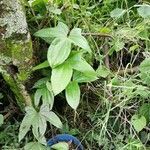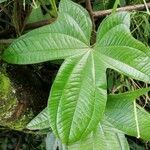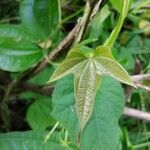Stems climbing sinistrorsely, glabrous, at least the lower conspicuously 4-winged on the angles; leaves alternate; petioles up to 15 cm. long, winged, minutely puberulous; leaf blades variable, the larger leaves deeply 5-lobed, over 15 cm. long and wide, the smaller leaves deeply 3-lobed (the lobes all acute), deeply cordate at base, pellucid-lineolate, minutely puberulous on upper surface and-along veins beneath; staminate spikes 2-5 in an axil, shorter than leaves, Un-branched, the rhachis subtomentose; flowers solitary (or subfasciculate?), short-pedicellate, the pedicels 1.5-2 mm. long, pilosulous; perianth segments oblong, about 2.5 mm. long, pilosulous externally; stamens 6, all fertile, borne on perianth segments, the filaments about 1 mm. long, the anthers 0.25 mm. long, introrse; rudimentary style conspicuous; ovary pilose; capsule 27 mm. long and 17 mm. wide (teste Knuth), puberulent.
More
A yam vine. The stem is square in cross section and does not have spines. The leaves are 25 cm long. They are opposite. The leaf is divided like fingers on a hand into 3 or more segments. The male flower is on a long stalk and the female flower stalk is short. It easily produces seed. The underground tuber is irregular in shape. It can be 70 cm long. Varieties can range in colour from white to purple and black.
It is a tropical plant. It is indigenous to Central America. It suits a cooler climate than other yams. It grows in areas with temperatures between 25-30°C. The rainfall is 1,500-2,000 mm per year. It cannot tolerate frost.



